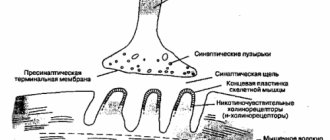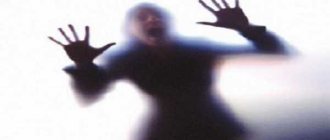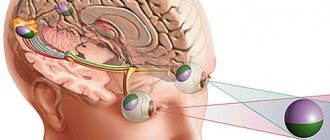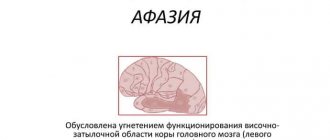Accommodation paresis is a critical condition of the eye, as a result of which it becomes impossible to examine small objects even at close range due to the obstruction of the clarity of the lens of the eye. This occurs due to changes in the size of the eyeball and the muscles around it.
After which, in old age, due to wear and tear of the lens, a person ceases to see. In childhood and adolescence, even myopia can lead to accommodation paresis. As a result, the child begins to see worse and worse.
Causes
The reasons for the development of the disease may be different. Most often, paralysis of accommodation occurs due to injuries and microtraumas. A temporary spasm may occur when the brain is contused or when looking at the sun. If severe damage occurs in the form of a burn, then the disease develops on an ongoing basis.
When neurological pathologies occur, paralysis of accommodation is a sign and can be treated if the root cause is eliminated.
There are the following causes of paralysis of accommodation:
- age-related changes;
- tumors;
- inflammation;
- tuberculosis;
- meningitis;
- previous injuries;
- infectious diseases;
- poor nutrition;
- intoxication with drugs or chemical elements;
- diabetes;
- constant physical overload.
The development of paralysis of accommodation also occurs naturally with aging. After forty-five years, the lens becomes inelastic and takes on an irregular shape. Eye strain and physical strain also influence the development of pathology. In order to avoid unpleasant manifestations, it is necessary to visit the doctor more often.
Forms of accommodation disorders
Accommodation disorders are quite multidisciplinary in terms of their pathogenesis. The paralysis considered today, for example, is simply inseparable from such a form of violation of the accommodative function of the eyes as paresis. These pathologies represent the inability of the ciliary muscle to tense, as a result of which accommodation completely or partially disappears. The difference between paralysis and paresis of the accommodative system lies precisely in the nature of the existing disorders. Thus, with paralysis, the ciliary muscle completely loses the ability to tense, and with paresis, a similar phenomenon manifests itself only partially.
Palsy of accommodation of the eye
In most clinical cases, paralysis of accommodation manifests itself in one eye, and paresis manifests itself in two visual organs at once. The nature of the manifestations of disorders varies among ophthalmologist patients and largely depends on the characteristics of their eye health. For example, in people without farsightedness or nearsightedness, accommodative paralysis manifests itself in the inability to read small print at close range, while nearsighted people can do this, but only when looking at a certain angle.
Thinning of the retina: diagnosis, treatment with drugs and vitamins
At the moment, there are three forms of paralysis and paresis of accommodation:
- Unilateral disorders that manifest as exclusive damage to the ciliary muscle or its ligament. Often, the so-called periphery of accommodation appears after injuries to the skull or a specific eye.
- Bilateral lesions resulting from improper control of the ciliary ganglion by the nervous system of the brain. That is, there are no defects in either the muscle or the lens ligament, but this unit refuses to work properly, as a result of which paralysis or paresis develops in both eyes at once.
- Isolated disorders, the pathogenesis of which is always associated with damage to the human central nervous system. According to the nature of the manifestation, this form of paralysis and paresis can be either bilateral or unilateral.
As noted above, the manifestation of certain forms of accommodation disorders is different. Paralysis usually affects a specific visual organ, but paresis often affects both eyes at once.
Symptoms
The main symptom of accommodative paralysis is blurred images. This will happen as soon as a person begins to look into the distance or examine objects closely. It happens that it is difficult for a patient to take a closer look at a certain element. Double vision may occur.
The following symptoms exist:
- eyes may get tired quickly when reading;
- to see the object, the patient has to squint;
- vision deteriorates;
- discomfort in the eye area, dryness, itching and redness may bother you;
- in some cases, nausea and trembling in the limbs may occur;
- burning sensations;
- inflammation of the eye mucosa;
- pain in the brain;
- I am worried about severe discomfort and constantly want to rub my eyes.
Patients often complain of constant and rapid fatigue. Schoolchildren who have a pathology can observe that they do not absorb information well. At the first manifestations of symptoms, you need to consult a specialist. First, he will conduct a diagnosis and then prescribe treatment.
Signs and symptoms of the disease
In schoolchildren, persistent paresis of accommodation develops between the ages of 7 and 15 years. Often caused by:
- stressful situations;
- acute general illness;
- diagnostic instillation of atropine.
Often these are children with diagnosed functional disorders of the central nervous system.
Patients usually complain of the following symptoms:
- inability to read;
- icon expansion (visually noticeable);
- inability to view the text (when tilting the head);
- automatic squinting of the eyes when looking at objects in the distance;
- constant redness of the eyes, squinting;
- deterioration of distant vision (sometimes);
- desire to rub your eyes.
In clinical practice, visual impairment, focusing disorders, and accommodation pathologies are the initial symptoms of damage to:
- botulism type B is a severe toxic-infectious disease associated with damage to the central nervous system;
- Adi's syndrome is a neurological disorder characterized by a monotonously dilated pupil. In 50% of patients diagnosed with Adi syndrome, astigmatism appears due to paresis of areas of the ciliary muscle.
Diagnostics
If paralysis of accommodation is suspected, an examination is carried out by a specialist and a medical history is collected. You should not wait until the symptoms go away on their own, this can lead to consequences. It is best to visit a medical facility immediately to avoid complications.
The following research methods are carried out:
- accomodometry is carried out with a special device to study the reaction of the eyes;
- biomicroscopy using this procedure examines the patient’s fundus;
- viziometry reveals visual acuity thanks to special plates;
- pachymetry makes it possible to find out the thickness of the cornea of the eye;
- Ergography This research method checks the mobility of the ciliary ligament.
It happens that a specialist may prescribe an ultrasound or MRI . If there are suspicions of neurological changes, the doctor will refer you for a consultation with a neurologist. In order to prevent further development of paralysis of accommodation, you need to consult a doctor at the first sign.
Differential diagnosis
The disease most often manifests in adolescence.
The clinical symptoms of paralysis of accommodation have common features with other diseases such as: optic neuritis, infiltration of the optic nerve in glioma and sarcoidosis, Chiari syndrome, Foster-Kennedy syndrome, Lyme disease, drug intoxication, medulloblastoma, lymphoblastic leukemia .
What is Sjogren's syndrome and how to get rid of it
To exclude these pathologies, a differential diagnosis of paralysis of accommodation is carried out. It includes a complex consisting of:
- Hardware refractometry.
- Rheophthalmography
- Ophthalmoscopy.
- Perimetry.
- Sonography.
- Visometry.
- Microscopic examination with a slit lamp.
- Computed tomography of the brain.
- MRI of the eyeball and brain.
- Accommodation studies using sets of negative and positive lenses.
Based on the results of this examination, the ophthalmologist will be able not only to accurately determine the presence of paralysis of accommodation. Such an examination will also help to establish the reasons for its development.
Treatment
- Paralysis of accommodation can be treated in different ways, it all depends on how advanced the disease is. cycloplegic eye drops . They provide effectiveness and relax the ciliary muscles. This improves eye mobility and dilates the pupil.
- It happens that the body lacks minerals and vitamins; they need to be replenished. It is very important that during paralysis of accommodation they are in balance. An ophthalmologist helps a patient choose glasses for vision. It happens that the patient can wear them on an ongoing basis, as well as sometimes. Your doctor may prescribe contact lenses.
- Laser correction is often used for accommodation . With its help, the thickness of the cornea changes, irregularities and various defects are removed. They, as a rule, lead to visual impairment. Physiotherapy can often be prescribed, which includes electrophoresis, acupuncture, massage treatments, and so on.
- It may be that the patient’s disease is triggered by injuries and various infections. Then all treatment is aimed at eliminating the root cause. It is best to consult a doctor on time in order not to trigger accommodation paralysis.
Treatment of paralysis of accommodation
The sooner the patient seeks help, the easier it is to deal with the problem. The ophthalmologist first prescribes special gymnastics for the eyes in combination with massage of the lumbar, shoulder, cervical region, as well as the head and temples.
It is very important to eliminate the main causes of paresis. To do this, you will have to reconsider your work and leisure schedule. Give up some hobbies for a while (embroidery, knitting, working with small parts, etc.). Eat strictly according to the schedule and get enough sleep.
Treatment is divided into several stages. At the end of each of them, the patient is temporarily put on a therapeutic bandage. Afterwards, the eyes are checked. If there are no visible positive changes, they resort to surgical intervention. If there are positive dynamics, various types of treatment are prescribed. This can be magnetic therapy, laser stimulation, electrophoresis, light treatment (chromotherapy), massage of the periorbital area.
Medicines are also used. The doctor selects drops that have a beneficial effect on the lens and improve pupil function. Eye drops provide only a temporary effect. They are used in combination with other types of treatment. It is necessary to strictly follow the doctor's recommendations.
Eye exercises
Experts advise performing certain eye exercises. This helps speed up the healing process. You can do them at home, as it is not difficult. The first thing you need to do is close your eyes for a couple of seconds and start blinking at a fast pace for about half a minute. If a person works on a laptop, then it is advisable for him to perform such actions regularly.
Next you need to go to the window and select the closest point. Start to gradually shift your gaze to distant objects and then to the tip of your nose. The exercise should be performed for about five minutes several times a day. Then you need to close your eyes and move your pupils in different directions. If you do exercises regularly, you can achieve a speedy recovery.
Accommodation indicators
The accommodative ability of the eye is expressed in diopters or linear values.
- Functional rest of accommodation is the absence of an accommodative stimulus in the visual field.
- The area of accommodation is the distance between the farthest (distance vision) and the nearest (near vision) points of clear vision.
- The volume of accommodation is the difference in the refractive index of the eye (in diopters) when set to the nearest and farthest points of clear vision.
Absolute volume (monocular) - the difference between maximum dynamic and static refraction, examined when the second eye is turned off. The volume of relative accommodation characterizes the possible range of changes in the tension of the ciliary muscle during binocular fixation of an object. There are positive and negative parts of the volume of relative accommodation - they are judged accordingly by the maximum minus or plus lenses, when used at a distance of 33 cm (the average working distance for near) the clarity of vision of the text is still preserved. - reserve is the unused part of the accommodation volume (in diopters) when the eye is positioned at the fixation point.
Accommodation indicators obtained from examining each eye separately are called absolute. And both of them are relative at once, because are performed with a certain convergence (reduction) of the visual axes.
Accommodation is closely related to convergence. At the same angle of convergence of visual lines, the accommodation costs in patients with different visual acuities are not the same. For example, children with uncorrected hyperopia (farsightedness) of moderate and high degree may develop accommodative convergent strabismus.
Preventive measures
In order to prevent paralysis of accommodation, it is necessary to follow some recommendations. First of all, it is necessary to have proper lighting for prolonged visual loads. If a table lamp is used, it should be placed on the left; for left-handers it should be on the right. There must be general lighting.
Maintain proper body position. As a rule, when reading, the distance between books should be about forty centimeters. The laptop must be placed so that it is slightly lower than eye level. Watching TV should be at a distance of about five meters. If you read while lying down, this primarily develops myopia.
If a person works for a long time, then he needs to take frequent breaks and rest for about five minutes. Regular physical exercise not only strengthens the body, but also eyesight. It is important that children play sports as they need to lead an active lifestyle. Massage procedures, swimming, and regular walks in the fresh air give positive results.
Proper nutrition is a must. The diet should contain vitamins and minerals. Eat spinach, cabbage, carrots, dried fruits. Be sure to eat fresh fruits and vegetables. If you follow all the recommendations, you can prevent paralysis of accommodation.
As soon as there is a suspicion of the development of pathology, you must immediately visit a doctor. If accommodative paralysis occurs, serious complications can occur. It is best to start treatment in a timely manner. The specialist will conduct a comprehensive examination and prescribe treatment. You should not self-diagnose, as this can lead to irreversible consequences. At the first manifestation of symptoms, you should consult a doctor. It is also important to follow preventive measures to prevent further development of the pathology.
Diagnostic methods
At the first manifestations of paresis or paralysis of accommodation, any person should immediately visit an ophthalmologist for a quality examination. Suspicions of violations of the accommodative function determine the need:
- Definitions of visual acuity.
- Determining the degree and correctness of convergence (intersection of visual fields).
- Ophthalmoscopy (examination of the fundus of the eye, as well as analysis of the conditions of the retinal tissue, large optic nerves and the vascular structure of the eyeball).
Siascopy - Skiascopy (determining the quality of the light-refractive properties of the pupil).
- Ultrasound examination of the eyeballs (detection of pronounced anatomical problems in the ciliary ganglion).
- Perimetry (checking the condition of central and peripheral vision).
- Magnetic resonance imaging of the brain (assessment of the state of the nervous system).
- Checking the correct reaction of the pupils to light.
Based on the results of the diagnostics, the examined patient is given an accurate diagnosis with a specific pathogenesis of accommodation disturbance. Depending on the identified causes of the problem, further treatment of the person is carried out either by the ophthalmologist himself or by a neuro-ophthalmologist (rarely a neurologist). It is better not to delay the treatment of paresis and paralysis of accommodation, therefore, when the first signs of such disorders appear, it is important to immediately seek professional help. Otherwise, the risks of developing irreversible consequences in the ocular apparatus are quite high, especially if the underlying causes of accommodation problems are serious.
Causes of swelling of the upper eyelids - what causes this phenomenon
Treatment and prevention
Symptomatic treatment usually begins with drops that dilate the pupil and relax the eye muscles, this allows the patient to immediately alleviate the condition. Then, as part of complex therapy, computer programs designed to relieve visual tension and various types of laser, magnetic and electrical stimulation are used.
Prevention of accommodation spasm involves maintaining the overall health of the body: maintaining a daily routine, eating well, not overworking and getting enough rest, giving the body adequate physical activity, and performing visual exercises. It is also useful to monitor your posture and periodically undergo a course of general massage with an emphasis on the cervical-collar area. This will not only increase blood flow and prevent accommodation spasms, but will also maintain the health of the body as a whole.
Sign up for an excimer clinic and learn more about your health!
You can call
or click the button and fill out the application form and receive a 5% discount on a full vision diagnostic
Make an appointment
Our address: Moscow, st. Marksistskaya, 3, building 1
"Excimer" on the map of the "Excimer" Clinic in other cities
Causes
Paralysis of the ciliary (ciliary) muscle of the eye impairs near vision, since its function of adjusting the degree of convexity of the lens is lost. There are central (nuclear) and peripheral (local) paralysis of the ciliary muscle.
Causes of peripheral paralysis:
- toxic - associated with the use of tools to assess the refraction of the eye;
- mechanical - eye injuries, blows, bruises;
- atrophy of the ciliary muscle - due to high intraocular pressure, or reduced motor activity of the internal ocular muscle, due to working with optical instruments.
Causes of central paralysis:
- damage to the ciliary ganglion or oculomotor nerve due to inflammation, swelling and hemorrhage, or other pathologies;
- nuclear palsy - due to tumors, chronic infections, multiple sclerosis, etc.;
- acute infections: the effect of toxins in food poisoning (botulism toxin);
- lesions of the meninges - tumor formations, tuberculosis, basic meningitis, fracture of the cranial base, etc.
Paralysis and spasm of accommodation of the eyes, treatment in children
comintour.net stroidom-shop.ru obystroy.com
Spasm of accommodation
Causes . Spasm of accommodation can develop in individuals with hypermetropia, hypermetropic astigmatism and presbyopia, who have intense close work and uncorrected refractive error.
Accommodation spasms are promoted by weakening of the body due to a general illness and insufficient nutrition, insufficiently developed ciliary muscles, intense visual work at a very close distance (closer than 30 cm) and insufficient lighting.
Spasm of accommodation can also be a consequence of the local and general action of drugs that cause contraction of the ciliary muscle (anticholinesterase and cholinomimetic drugs, organophosphorus compounds, etc.).
Symptoms . Patients note a sharp decrease in distance vision while maintaining it completely at close range.
In such individuals, there is a constriction of the pupil and a decrease in the depth of the anterior chamber. Myopic refraction is determined, which is not sufficiently corrected.
The real picture emerges after relaxation of accommodation.
Treatment of accommodation spasm
Treatment for spasm of accommodation depends on the causes that caused it. If the spasm of accommodation is caused by an uncorrected refractive error or presbyopia, it is necessary to determine the refraction of the eye using an objective method under conditions of cycloplegia and carry out its optimal correction. This also applies to presbyopia.
If the ciliary muscle is insufficiently developed, its training is prescribed by changing the point of view far and near according to the Avetisov method or using diverging lenses according to the Dashevsky method. It is also possible using other methods (holey glasses).
Avetisov's technique
The patient stands in front of the window at a distance of 30-35 cm from the window glass, on which a round mark with a diameter of 3-5 mm is pasted. In the distance, along the line of sight passing through this mark, it designates some object for fixation. Then he alternately looks at the mark on the glass, then at an object in the distance.
The exercise is performed for 10 minutes twice a day for 2-3 weeks. Repeat the exercises after 10-15 days until normal accommodative ability of the eyes is achieved.
Dashevsky's technique
The patient sits in front of a table to study visual acuity.
A weak diverging lens is placed in front of each eye, starting from 0.5 diopters, for such a time during which the visual acuity initially deteriorated by the lens again increases to the initial level due to reflex contraction of the ciliary muscle. The refractive power of the lenses is gradually increased by 0.5 diopters until the eye, due to accommodation, can improve vision to the previous level.
Every day the refractive power of the last glass will increase, which will indicate strengthening of the strength of the ciliary muscle and an increase in the volume of accommodation.
Training is carried out daily for 10 minutes, twice a day for 2-3 weeks. You can repeat the exercises after 10-15 days.
With exercises, it is necessary to increase the volume of accommodation to 2/3 or 3/4 of its volume, depending on the patient’s age.
Along with training the ciliary muscle, general strengthening and tonic treatment is also carried out. It is recommended to strengthen the body with physical exercise in the fresh air.
The optimal visual load mode is established. Visual work should take place in good lighting, the distance for reading and writing should be no closer than 30 cm. It is recommended to take breaks from work every 30 minutes of work for 10-15 minutes.
Paralysis of accommodation
Causes . The cause may be local application of cycloplegic drops (atropine sulfate, scopolamine hydrobromide, etc.) into the conjunctival sac and a consequence of intoxication (botulism, diphtheria toxin) or oral or parenteral administration of drugs that contain alkaloids of the atropine group and other drugs.
Symptoms . Patients note decreased vision at close range, and some at distance (persons with hypermetropia).
The pupil is dilated and does not react to light. The anterior chamber is deep.
Treatment of paralysis of accommodation
It is necessary to discontinue medications that contain atropine alkaloids.
In case of poisoning, detoxification therapy is carried out. Prescribe treatment for diseases that lead to general intoxication of the body.
Miotics are instilled into the conjunctival sac.
Source: https://konjuktivita.net/paralich-spazm-akkomodacii-glaz-lechenie-detej.html











